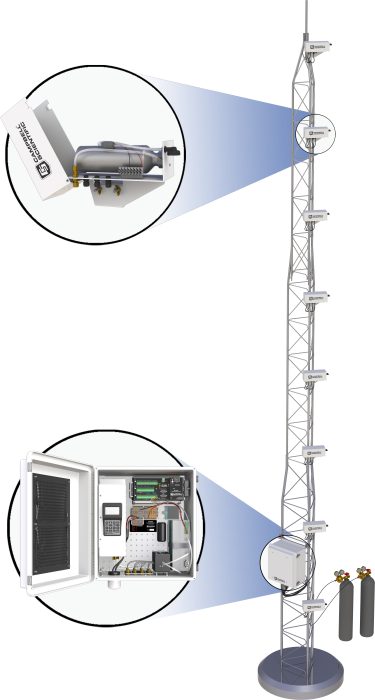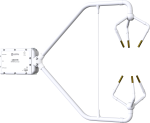
vorprogrammiert, geringer Stromverbrauch






Überblick
Das AP200 ist ein komplettes integriertes CO2 und H2O Profilmesssystem. Es misst Kohlendioxid- und Wasserdampfkonzentrationen von bis zu 8 Messstellen, die normalerweise in verschiedenen Höhen an einem Turm angebracht sind, um ein Vertikalprofil zu erhalten. Es wird häufig zusammen mit einem Eddy-Kovarianzsystem verwendet um den Speicheranteil zu bestimmen und ein kompletteres Bild des Gasaustausches zu bekommen.
Lesen Sie mehrFunktionen und Vorteile
- Fully integrated system
- Requires only 13 W (average at 25°C and 12 Vdc)
- Contains a Campbell Scientific CR1000X Measurement and Control Datalogger
- Automatically performs CO2 zero and span
- Automated temperature and pressure control
- Data logger program included
Bilder


















Zugehörige Produkte
Technische Beschreibung
Measurements
Primary:
- CO2 concentration at each intake
- H2O concentration at each intake
- System diagnostic word
Secondary:
- Sample flow rate
- Sample cell pressure
- Sample cell temperature
- Other control variables
| Note: Contact a Campbell Scientific applications engineer from the micromet group for questions or updates regarding the datalogger program. |
Spezifikationen
System Enclosure |
|
| Operating Temperature | -30° to +45°C |
| Power Requirements |
|
| Dimensions | 52.1 x 44.5 x 29.7 cm (20.5 x 17.5 x 11.7 in.) |
| Weight |
|
Pump Module |
|
| Pump Type | Dual-head diaphragm pump with a brushless dc motor |
| Mounting | Mounted in an insulated, temperature-controlled box inside system enclosure |
| Control | Pumping speed is automatically controlled to maintain the pump inlet pressure at the set point |
| Maximum Pumping Speed | 9.0 liters per minute (LPM) |
| Pressure Sensor Range | 15.0 to 115.0 kPa |
| Heater | 8.0 W (turns on/off at 2°C) |
| Warm-up Time | ~50 min (from -30° to +2°C) |
| Fan | 0.7 W (turns on at 50°C and off at 45°C) |
Valve Manifold |
|
| Mounting | Mounted inside system enclosure |
| Inlets | Eight air sample inlets plus one inlet for zero, one inlet for CO2 span, and one inlet for H2O span |
| Connections | 0.25-in Swagelok |
| Mass Flow Sensor | 0 to 1.0 standard liters per minute (SLPM) |
| Heater | 8.0 W (turns on/off at 5°C) |
| Warm-up Time | ~20 min (from -30° to +4°C) |
| Fan | 0.7 W (turns on at 45°C and off at 43°C) |
Intake Assembly |
|
| Filter | 1.0-in diameter, sintered stainless-steel disk filter, 10-micron pore size |
| Orifice Heater | 2 kohm (0.07 W at 12 Vdc) |
| Mixing Volume | 750 mL |
| Sample Connection | 0.25 in. Swagelok |
| Number of Connections for Heater Cable Entry Seals | 3 (1 in, 2 out) |
| Cable Diameter for Heater Cable Entry Seals | 2.8 to 6.6 mm (0.11 to 0.26 in.) |
| Wire Diameter for Heater Cable Screw Terminals | 26 to 12 AWG |
| Wire Stripping Length for Heater Cable Screw Terminals | 5.0 mm (0.2 in.) |
| Screw Tightening Torque for Heater Cable Screw Terminals | 0.4 N•m |
| Orifice Inside Diameter | 0.178 mm (0.007 in.) |
| Dimensions | 31 x 12.5 x 19 cm (12 x 5 x 7.5 in.) |
| Weight | 1.4 kg (3.1 lb) |
Dokumente
Broschüren Produkte
Realisierte Projekte
Downloads
AP200 CR1000 Program v.2.01 (31.3 KB) 12-01-2021
AP200 CR1000(X) Program.
Compatible with the LI-850.
Note: For those with the LI-840 contact Campbell Scientific for compatible code.
Device Configuration Utility v.2.29 (54 MB) 15-11-2023
A software utility used to download operating systems and set up Campbell Scientific hardware. Also will update PakBus Graph and the Network Planner if they have been installed previously by another Campbell Scientific software package.
Supported Operating Systems:
Windows 11 or 10 (Both 32 and 64 bit)
FAQs für
Number of FAQs related to AP200: 53
Alle anzeigenWenige anzeigen
-
The automatic zero/span function of the AP200 is designed to do both a zero and a CO2 span. However, it is possible to disable the CO2 span and do only a zero. To do this, set public variable CO2_SPAN_PPM =0.
-
The number of intakes required at a site depends on the characteristics of the canopy. For example, the canopy’s height and density directly affect the change in CO2 and H2O concentrations. Order enough intakes to accurately profile these concentration changes. The AP200 may be ordered with anywhere from four to eight intake assemblies.
-
The spacing depends on the canopy and atmospheric conditions. It is important to know where the concentration gradients are the steepest.
For example, in a low agricultural crop canopy, it may be appropriate to use a logarithmic distribution within and near the top of the canopy, and a linear distribution above the canopy: 0.2 m, 0.4 m, 0.8 m, 1.6 m, 3.2 m (logarithmic) and 5 m, 7 m, 9 m (linear).
-
Cylinders of zero air and CO2 span gas are needed. Each cylinder must have a pressure regulator. The cost for the two cylinders and two regulators may be approximately $1,000. Typically, there is also a nominal monthly fee to lease the cylinders. Contact Campbell Scientific for more detailed information.
-
Configure the AP200 to set the zero and CO2 span. This will provide better accuracy than simply measuring the zero and span tanks and doing a correction in post-processing.
-
A non-zero value can be used to perform a zero/span on an interval that is not synchronized to midnight (for example, every three hours starting at 0100 hrs).
-
Possibly. For example, to measure advection because of a drainage flow on sloping terrain, an AP200 system could be deployed with two towers, upstream and downstream along the slope, with four intakes on each tower.
-
It depends on the type of chambers. The AP200 requires a constant flow of sample air for each intake, so it will not work with small chambers that require the air sample to recirculate. However, it might be possible to use the AP200 with chambers that allow a continuous sample flow to be extracted.
-
The AP200 uses ¼ in. tube fittings. Tubing with a 6 mm outer diameter (OD) will not fit, unless a 6 mm to ¼ in. reducer is used on each end of each tube.
-
The intake tubes can be quite long—up to a few hundred meters. Contact Campbell Scientific to ask about specific requirements for an application.
Anwendungsbeispiele
The Warra long-term ecological research (LTER) site located in Southwestern Tasmania was founded in 1995......lesen Sie mehr






